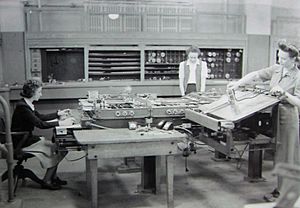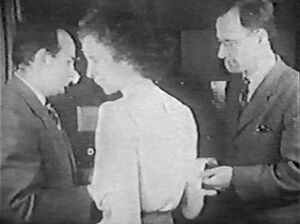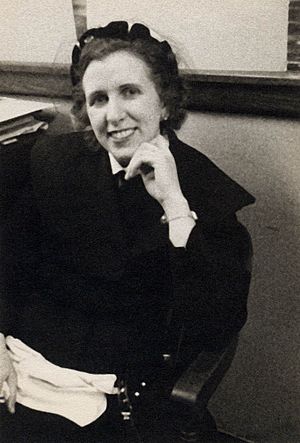Kathleen Antonelli facts for kids
Quick facts for kids
Kathleen Antonelli
|
|
|---|---|

Kay McNulty in her high school graduation portrait, 1938
|
|
| Born | February 12, 1921 |
| Died | April 20, 2006 (aged 85) Wyndmoor, Pennsylvania, US
|
| Nationality | Irish |
| Alma mater | Chestnut Hill College |
| Known for | One of 6 original programmers of the ENIAC |
| Spouse(s) | John Mauchly (1948–1980), Severo Antonelli (1985–1996) |
| Scientific career | |
| Fields | Mathematics, Computer Science |
| Institutions | Moore School of Electrical Engineering, University of Pennsylvania Aberdeen Proving Ground |
Kathleen "Kay" McNulty Mauchly Antonelli (born February 12, 1921 – died April 20, 2006) was a pioneering Irish computer programmer. She was one of the first six people to program the ENIAC, which was one of the very first electronic digital computers built for general use.
The other five original ENIAC programmers were Betty Holberton, Ruth Teitelbaum, Frances Spence, Marlyn Meltzer, and Jean Bartik. These women played a huge role in the early days of computing.
Contents
Early Life and Education
Kathleen Rita McNulty was born in a small Irish-speaking village called Feymore in County Donegal, Ireland, on February 12, 1921. Her father, James McNulty, was arrested the night she was born and spent two years in prison. In 1924, when Kay was three, her family moved to the United States and settled in Philadelphia, Pennsylvania. When she first arrived, she could only speak Irish, but she quickly learned English.
Kay attended school in Philadelphia and showed a strong talent for mathematics. In high school, she studied algebra, geometry, and trigonometry. After graduating in 1938, she went to Chestnut Hill College for Women. There, she took every math course available, including advanced topics like calculus and statistics. She earned her degree in mathematics in June 1942. She was one of only a few math majors in her graduating class.
During college, Kay knew she wanted a job using her math skills, but she didn't want to be a school teacher. She learned that jobs at insurance companies, called actuarial positions, often required a master's degree. To make herself more likely to get a job, she also took business courses like accounting and economics.
Career in Computing
Becoming a Human Computer

Soon after graduating college, Kay saw an advertisement for women with math degrees to work for the US Army during World War II. The Army needed people to calculate the paths of bullets and missiles for artillery. This work was done at the Ballistic Research Laboratory, which had staff at the Aberdeen Proving Ground and the Moore School of Engineering at the University of Pennsylvania.
In June 1942, Kay and her friend Frances Bilas were hired as "human computers." This meant their job was to do calculations by hand. They earned $1620 a year, which was considered good pay at the time. They worked at the Moore School of Engineering. Their main task was to calculate ballistics trajectories for firing tables. They used mechanical desk calculators and very large sheets of paper. This work was important for the war effort.
Kay and Frances started with about 10 other women and 4 men. They worked in a large classroom at the Moore School. This same room would later be where the ENIAC computer was built. Even with their math training, the work was new to them. They had to learn how to do complex calculations, accurate to ten decimal places, through practice and help from their supervisor. About 75 women worked as human computers at the Moore School during this time. Each gun needed its own firing table, which had about 1,800 trajectories. Calculating just one trajectory by hand took about 30 to 40 hours.
After a few months, Kay and Frances started working with the differential analyser. This was a large, advanced mechanical calculator located in the basement of the Moore School. It was one of only a few such machines in the world. Using the analyser, a single trajectory calculation that took 40 hours by hand could be done in about 50 minutes. Kay was promoted to supervise the calculations on this machine.
Programming the ENIAC

The ENIAC (Electronic Numerical Integrator And Computer) was created to do these same ballistics calculations much faster. It was developed between 1943 and 1946. In June 1945, Kay was chosen to be one of its first programmers. The other women selected were Betty Snyder, Marlyn Wescoff, Ruth Lichterman, and Betty Jean Jennings. They received training on the IBM punched card equipment that the ENIAC would use. Later, Kay's college friend, Frances Bilas, also joined the ENIAC programming team.
The ENIAC could complete the same ballistics calculations in about 10 seconds. However, it often took one or two days to set up the computer for a new problem. This setup involved connecting plugs and setting switches. The programmers had to figure out the exact steps needed for each calculation and then physically set up the ENIAC. Kay McNulty is even credited with inventing the idea of a "subroutine," which is a smaller program used within a larger one, to help solve complex problems.
Because the ENIAC was a secret project, the programmers were not allowed to see the machine at first. They worked from blueprints in another room. Programming the ENIAC meant breaking down complex math problems into tiny steps that the machine could understand. Once they planned a program on paper, they were allowed into the ENIAC room to physically program the machine.
A lot of the programmers' time was spent running test programs. This was to make sure that every part of the ENIAC, like its vacuum tubes and electrical connections, was working correctly before they ran a real problem.
When the ENIAC was officially launched, Kay and the other women who had worked on it were told to act as hostesses. They were asked to stand near the machine and "look good." Because of this, they did not receive the public recognition they deserved at the time.
In mid-1947, the ENIAC was moved to the Aberdeen Proving Ground. Kay, along with Ruth Lichterman and Frances Bilas, also moved there to continue working with the computer.
Personal Life
John Mauchly, one of the inventors of the ENIAC, often visited the computer at Aberdeen. He had started his own computer company and wanted Kay to join him. Instead, Kay married John Mauchly in 1948 and left her job at Aberdeen. They lived in Ambler, Pennsylvania, and had five children together: Sally, Kathy, Bill, Gini, and Eva.
Later Life and Legacy
Kay McNulty continued to work on software design for later computers, including the BINAC and UNIVAC I, which her husband designed. John Mauchly passed away in 1980.
In 1985, Kay married photographer Severo Antonelli. He died in 1996 after a long illness. Kay herself had a heart attack while caring for him but fully recovered.
After John Mauchly's death, Kay helped keep the story of the ENIAC pioneers alive. She wrote articles, gave talks (often with her lifelong friend Jean Bartik), and gave interviews to reporters and researchers.
In 1997, Kay was inducted into the Women in Technology International Hall of Fame, along with the other original ENIAC programmers. In 2002, she accepted the induction of John Mauchly into the National Inventors Hall of Fame.
Kay McNulty died from cancer on April 20, 2006, at the age of 85.
Legacy
In 1997, Kay Antonelli was recognized for her important work by being inducted into the Women in Technology International Hall of Fame. This honor was shared with the five other ENIAC programmers.
For a long time, Kay and her fellow programmers did not get the credit they deserved. This was partly because they were women, and also because their work was kept secret during the war. However, in 2010, a documentary called "Top Secret Rosies: The Female "Computers" of WWII" was released. This film featured interviews with three of the six women programmers, highlighting their amazing contributions during World War II.
The ENIAC team also inspired the award-winning 2013 documentary The Computers. This film includes old footage of the ENIAC team from the 1940s and new interviews with the women as they remember their time working together.
In July 2017, Dublin City University (DCU) in Ireland honored Kay Antonelli by naming their computing building after her.
In 2019, the Irish Centre for High-End Computing (ICHEC) named its new supercomputer "Kay" after her. This supercomputer serves as Ireland's national supercomputer for academic researchers.
Images for kids
See also
 In Spanish: Kathleen McNulty Mauchly Antonelli para niños
In Spanish: Kathleen McNulty Mauchly Antonelli para niños






